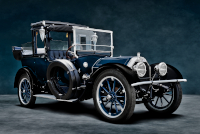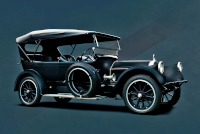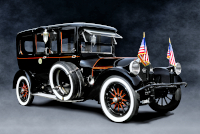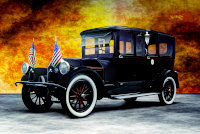Pierce-Arrow Model 51 Vestibule Suburban, President Woodrow Wilson, #511121, 1919
Location:
Radnor Hunt Concours d'Elegance, 2007
Owner: Woodrow Wilson Presidential Library and Museum | Staunton, Virginia
Prologue:
What little we can do with old stock. I had long ago published the main image, and recently worked up a second perspective with some unfortunate glare, along with a halfway decent gander at the vestibule compartment. These are paltry visuals relative to the car's significance. Still, we were fortunate to see the car on public display. As a presidential coach, chassis #511121 is surely one of the most significant Pierce-Arrows. But for all its service to Woodrow Wilson, the private citizen, it is more pleasingly sentimental than that. The car was a vital part of his life, accompanying him through grand political accomplishments and also his mundane daily leisure. Even without spectacular imagery, collecting these stories in a freely accessible medium is worth the effort.
- - - - - - - - - -
► Image Source: Nikon D200 (10.2 MP)
References:
- Ralston, Marc. "Pierce-Arrow" A.S. Barnes & Co., Inc., San Diego, CA. 1980, page 89, 116, 231
- Automobile Quarterly, Volume 37, Number 2, December 1997, "Chariot of the Chief" by Stuart W. Wells, The Kutztown Publishing Company, Inc., Kutztown, PA, page 6-13
- Automobile Quarterly, Volume 28, Number 4, Fourth Quarter 1990, "The Big Pierces" by Bernie Weis, The Kutztown Publishing Company, Inc., Kutztown, PA, page 51-52
- Woodrow Wilson Presidential Library and Museum: The museum's own description and images.
Wilson's Model 51 Pierce-Arrow lives today in its restored garage at the Woodrow Wilson Presidential Library and Museum. Exercised regularly, the car is apt to attend historical events as much as automotive events, whether related to Wilson's presidency or Princeton University. Just prior to Automobile Quarterly's survey, the car attended Princeton's 250th anniversary in 1996. We encountered the Model 51 about ten years later at Radnor Hunt as part of a Pierce-Arrow homage. And it best be included, this car's story—quite a common story in many respects—a car so very closely connected to a man, his work, and his personal life. Except that man happened to be president of the United States.
President Woodrow Wilson and the Pierce-Arrow Model 51
Unlike his predecessors, President Woodrow Wilson was not an early adopter of the motorcar phenomenon. Automobile Quarterly notes that, "while he was president of Princeton University, he railed against the elitism of car ownership in a 1906 speech," the same year Pierce expanded operations on the former Pan-American Exposition grounds to serve the American elite. Wilson opted for horse and carriage to attend church, perhaps out of fealty for similarly austere sentiments. But his views changed while in office. Both he and First Lady Edith Wilson drove the White House's Baker Electric Special Victoria, which had served First Lady Helen Herron Taft before. Wilson signed the Federal Aid Road Act of 1916 on July 11, which provided the first federal funding for road construction and began the transformation of primitive mud bogs into passable, weather-permeable roadways. And in 1917 Wilson became the first president to join the American Automobile Association (AAA).
President Wilson's relationship with this Pierce-Arrow is remarkable. The Model 51 replaced a Herculean 1916 Pierce-Arrow Model 66-A-4. The new Model 51 first entered the White House fleet as a conveyance to bring Wilson from the Capitol in 1919 after he spoke in support of signing the Treaty of Versailles, which in late June would signify the nominal end of World War I. This car would become President Wilson's favorite vehicle. Mr. George Howard, Wilson's chauffeur, drove the president and first lady at sedate speed, hardly ever beyond 25 miles per hour. However, Howard would also drive the car to the Buffalo factory twice a year to exchange the vestibule suburban body for an open touring body, and vice versa. On these trips he cruised at about 50 mph, still far below the car's potential. Despite antediluvian appearances, Pierce-Arrow built cars to a superior formula sine qua non. With its cast aluminum body, four-speed gearbox, and four-valve-per cylinder inline-6 motor, the Model 51 provided performance and comfort that matched post-War standards some 50 years later. This presidential car also uses Westinghouse air springs—an early after-market adjustable shock absorber system—for enhanced ride quality.
On September 25th of 1919, Wilson collapsed while campaigning for the League of Nations, soon to be founded in January of 2020 at the Paris Peace Conference, drawing World War I to a political conclusion. For his involvement, President Wilson would win the Nobel Peace Prize in 1919. But that year Wilson also suffered a paralytic stroke on October 2nd. For his declining health, the car became more vital, offering mobility and comfort unavailable prior to the automotive advent, (and exclusive to Pierce-Arrow besides). The car became Wilson's connection to the world.
Wilson so liked the car that, upon leaving office in 1921, his close friends purchased the Model 51 from Pierce-Arrow, along with the second touring car body. He retained the services of Mr. Howard as chauffeur, who drove Wilson on a daily ride. Wilson installed a buzzer to signal directions to Howard—buzz to stop, buzz-buzz to turn left, and buzz-buzz-buzz to turn right. As Wilson was also an avid baseball fan, Howard would park at Griffith Stadium, (prior to 1923 known as Boundary Field or National Park) in Washington DC to watch the Senators play. Owner Clark Griffith related, "He was a sick man, so he'd remain in his limousine, parked along the right field line. We'd detail a reserve catcher to sit on the front fender to ward off line drives."
Perhaps the strongest indication of the car's importance to Woodrow Wilson, after his death on February 3rd, 1924, Edith Wilson immediately sent the Pierce-Arrow to Staunton, Virginia in contribution to a memorial at his birthplace. From the earliest moment, she recognized what the car represented, as it had been right there with Wilson from his most vaunted presidential engagements to his casual afternoons. The market crash of 1929 delayed plans, and the car fell into disrepair. Gradual restoration did not begin until 1971.
The trustees of the Woodrow Wilson Birthplace Foundation sent #511121 to Charles Goodwich Thompson and Ludwig Senden of South Tamworth, New Hampshire. The car became lost in transport and presumed stolen for a few days until authorities recovered the hauling rig at a New Jersey truck stop. The driver had simply walked away from the job. In 1973, Thompson and Senden had completed the major body and frame repairs, refurbishing the car in running order. The Pierce-Arrow toured Prospect House, Wilson's home while president of Princeton University, and Wilson's S Street home in DC. Mechanical repairs followed in 1989, completed in Virginia by Horch Restoration and B.T. Morgan Howen Associates, with new pistons from Egge Machine Company of California.
A Strange Irony: US Presidents and the First Motorcars
President William McKinley rode in a Stanley Steamer in 1899, the first president to ride in an automobile. Theodore Roosevelt owned a White steam car, as did President Elect William Howard Taft, his a 1909 White Model M 40 hp Seven-Passenger Touring (often cited erroneously as a "white Stanley Steamer"). But as president, Taft would purchase two new Pierce-Arrow cars. Pierce-Arrow would then serve the White House for nearly three decades, peaking during the Coolidge administration (when the White House leased five), and ending in 1936 during Franklin D. Roosevelt's presidency. The irony is that the choice presidential car of the new era was produced in Buffalo, New York on the very same grounds where McKinley had been assassinated. Seeking space to grow, in 1906 the George N. Pierce company purchased land at 1695 Elmwood Avenue, the northwest corner of the 1901 Pan-American Exposition where McKinley was twice shot by Leon Czolgosz. Mere coincidence. History also notes that McKinley then became the first president to ride in an electric vehicle, as the ambulance that carried him to the exposition's medical facilities was an electric truck.
Motor: 8,586.8 cc (524 cubic inch) Series 5 Dual-Valve inline 6-cylinder | 114.3 mm x 139.7 mm (4½" x 5½")
The motor is cast iron, cast in pairs of three cylinders. The head is detachable.
Valvetrain: T-head, 4 valves per cylinder, twin-plug ignition via Delco dual distributor
Pierce-Arrow's "dual-valve" name refers to two intake valves and two exhaust valves per cylinder, creating a 4-valve, flathead motor.
Power: 48 rated horsepower @ 2,500 rpm
Actual power output for the motor, which in the company catalogue equals the Model 48 Series 5, is 92 hp.
Drivetrain: 4-speed manual transmission, rear-wheel drive
Front Suspension: semi-elliptic leaf springs and Westinghouse air springs
Rear Suspension: live axle with three-quarter-elliptic leaf springs, Westinghouse air springs
Architecture: steel frame, cast aluminum body
The Models 31 and 51 are the final series to use Pierce-Arrow's incomparable cast alloy body.
Kerb Weight: 2,313.3 kg (5,100 lbs)
Wheelbase: 3,606.8 mm (142 inches)
Etymology:
In 1919, Pierce-Arrow retired the 38-48-66 model naming convention, reducing the line to just two models, the Model 31 and the Model 51. These are alternatively known as Series 5 cars. Both models provide much improved performance over the previous four series. The Model 31 replaced the Model 38-C-4. The Model 51 replaced the Model 48-B-4. Pierce-Arrow did produce a Model 48-B-5, a fifth series Model 48, in 1918 and 1919; this car is roughly the same as the Model 51 that came into place in 1919, as they use the same fifth series 48 hp dual-valve motor. Actual power far exceeds the rated figure, and overall performance betters the outrageous Model 66. Pierce-Arrow would produce a handful of fourth series Model 66 cars in 1919, but these are much less practical with little advantage over the Model 51.
The translation of outgoing 38-48-66 models to 31 and 51 seems to be that Pierce-Arrow revised the 38 as a 3-something car and used '1' as the logical place to start with the next series. The Model 51 is a single model that replaces both the 48 and 66. Pierce-Arrow probably figured that 5 fit right in between those outgoing models. Again, the company started the new series at 1, creating the 51. But unlike the Model 31, the Model 51 will not see a direct successor; it is a standalone product one series run from 1919 to 1920. Later in 1932, another Pierce-Arrow Model 51 will appear, but this is a completely different car with no relation to the 1919 model.
'Vestibule' refers to the arch over the passenger compartment door. The suburban body style is the largest of the limousine-type cars offered by Pierce-Arrow. We identify the car's preparation for President Woodrow Wilson, along with the chassis number.
Figures:
Pierce-Arrow manufactured approximately 2,250 Model 51 cars from 1919 to 1920. Of those, the vestibule suburban would be a premium option. The White House leased chassis #51151 from Pierce-Arrow, preparing the car for Wilson's Capitol address in support of the Treaty of Versailles in 1919. Wilson's friends then purchased the car from the factory at the close of his presidency in 1921. The car is unique in its relationship to President Wilson, and for its service as his personal daily car until his death in 1924.
Value:
A new 1919 Model 51 Vestibule Suburban of this specification cost $9,450. When President Wilson's friends purchased the car for him following his presidency, they negotiated an even $3,000 cash for the car and its extra touring body (#930).
Livery and Insignia: Visual References to Woodrow Wilson
While black would be standard for a presidential limousine, the bright orange pinstripes recall Woodrow Wilson's role as Princeton University President. The car wears presidential seals on both vestibule doors, though these were not applied in period, whether during Wilson's presidency or after. The badge on the grille represent's Wilson's 1917 AAA membership, the first president to join.
As Wilson's personal car, the Model 51 used a Princeton Tiger mascot, symbol of pride in his alma mater and the university he remained closely connected to as former president. Wilson's chauffeur, George Howard, recalled that the original presidential eagle mascot was still in the garage at Wilson's DC home on S Street. So the Wilson House directors donated the eagle mascot, which appears on the car today. I must admit that, in my old photographs, it is disappointing that the flags obstruct the eagle from view.
Passenger Compartment: Pierce-Arrow Model 51 Interior Appointments
Inside, the seats use pinstripe broadcloth. Two jump seats accommodate occasional passengers; a jump seat example can be seen in our Model 38-C-3 Town Car Landau profile. The windows are fitted with silk shades and the partition window a draw-down screen, which Wilson was not apt to use. The German silver sconces outside the vestibule doors are electric, served by black push-button switches common of the era. This style of electric sconce first appeared in late 1910 and became standard on closed cars in 1911, one of the first electric lights in Pierce-Arrow's developing electrical system. The sconces remained little changed until the last of these grand limousines in 1919. From the factory, the passenger compartment also came with silver bud vases, but Edith Wilson disposed of those, considering them, in Automobile Quarterly's words, "not manly enough for the presidential limousine." The passenger door handles are silver-plated.
Aluminum Alloy: Notes on the Cast Alloy Vestibule Suburban
Always important to note, the Pierce-Arrow body of this era is cast aluminum. Flanges cast into the body moulds are then cold-riveted together. Compared to traditional steel panels over a wood frame, the Pierce-Arrow car is exceptionally rigid, with the added rust resistance, dent resistance, and structural integrity that comes from a cast alloy form. By using casts, Pierce-Arrow engineered the body with variable thicknesses depending on the section and its structural demands. An engineered cast allowed the body to be bolstered where required, and light where permissible. Pierce-Arrow moreover standardized the process to build repeatable, lasting durability to the same astronomically high standard in every car. So it is important to point out that while this Model 51 looks every bit the part of a 100+ year-old car, in actuality it is rather space-aged in its construction approach. Pierce-Arrow also used alloy in major mechanical components, including the crank case, oil pan, intake manifold, and transmission housing. (They also experimented with an all-alloy 4-cylinder, but found the performance lacking.) Thus, an antique Pierce-Arrow is remarkable in that latter cars use far less alloy than their ancestors.
The reduction is first due to cost, as these early Pierce-Arrow cars were extremely expensive, and second due to changing attitudes in style. The circumstance is rather similar to Lancia in Italy. Where Lancia used a monocoque chassis from 1922, the ensuing custom coachbuilder era demanded a conventional body-on-frame platform. Both Pierce-Arrow and Lancia developed automobiles that were extraordinary for their time, but that the force of art would eradicate decades before the rest of the industry caught up. So a Pierce-Arrow from the teens is built on more advanced engineering standards than those of the 1920s, just as a Lancia from the 1920s is built on more advanced engineering standards than those of the 1930s. In short, we tend to think of technology as a linear progression, but in reality there are human factors that deter technology from following its own dispassionate course.
Last Updated: Mar 26, 2025
Editor's Picks


© Copyright 2008-2025, 12cylinders.com | images and text by Dominic Anthony



